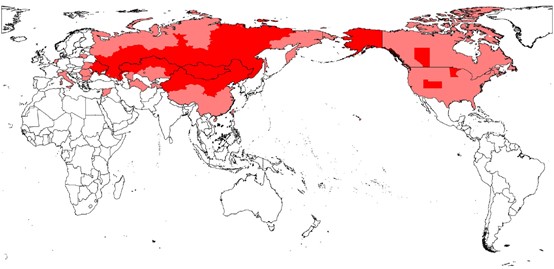IPPCAAS scientists revealed the transboundary migration patterns of Loxostege sticticalis among China, Russia and Mongolia
Recently, a research paper entitled "Transboundary migration of Loxostege sticticalis (Lepidoptera: Crambidae) among China, Russia and Mongolia" was published in Pest Management Science by the Migratory Pests Research Group from the Institute of Plant Protection, Chinese Academy of Agricultural Sciences, focusing on the transboundary migration pattern of L. sticticalis in China, Russia and Mongolia.
L. sticticalis is a global pest affecting many crops, with seasonal migration patterns and periodic outbreaks in Asia, Europe and North America, and is listed in China's "List of Class I Crop Pests and Diseases". There are a large number of records of long-distance migration of Loxostege sticticalis in China, but the transboundary migration pattern between China, Russia and Mongolia is still unknown.
In this study, We performed a phase analysis of L. sticticalis periodic outbreaks among three countries based on 30 years of historical population data, analyzed the wind systems during migration over boundary regions, and traced the migratory routes in a case study of outbreaks in 2008 by trajectory simulation. The results showed that highly synchronized outbreak years of L. sticticalis were observed between China and Mongolia, China and eastern Siberia, China and western Siberia, Mongolia and eastern Siberia, eastern Siberia and western Siberia from 1978 to 2008, indicating possible transboundary migration between these regions. Winds at 300–600 m altitude, where adult migration usually occurs, also showed a high probability of northwestern winds in Haila'er (China), Chita (Russia) and Choybalsan (Mongolia), favoring successful adult migration from these areas to northern and northeastern China. Back trajectory analysis further showed that the first-generation adults that caused the severe outbreak of second-generation larvae in 2008 originated from eastern Siberia, eastern Mongolia, and the boundary regions of China–Russia and China–Mongolia.
Our findings demonstrated that the source of L. sticticalis outbreaks in northern China was closely related to the outbreaks in Siberia and Mongolia via long-distance transboundary wind borne migration. This information will help guide international monitoring and management strategies against this notorious pest.
This research was supported by the National Key Research and Development Program of China (2022YFD1400600), the China Agriculture Research System of MOF and MARA (CARS-22) and Government Purchase of Public Services of MARA(15226006).
Original link: https://doi.org/10.1002/ps.8183

Figure 1. Distribution map of Loxostege sticticalis in China, Mongolia, Russia, Kazakhstan, Ukraine, North America and Europe.
-
 China-Laos Training Workshop on Integrated Management of Destructive Crop Pests and Diseases Successfully held in Laos
China-Laos Training Workshop on Integrated Management of Destructive Crop Pests and Diseases Successfully held in Laos -
 New Plant Protection: New challenge and new opportunity for plant protection
New Plant Protection: New challenge and new opportunity for plant protection -
 International and SELAMAT Conference on Pesticide Residue and Mycotoxin Contamination Held in Beijing
International and SELAMAT Conference on Pesticide Residue and Mycotoxin Contamination Held in Beijing -
 CAAS President Meets Chairman of ASEAN FAW Taskforce
CAAS President Meets Chairman of ASEAN FAW Taskforce
